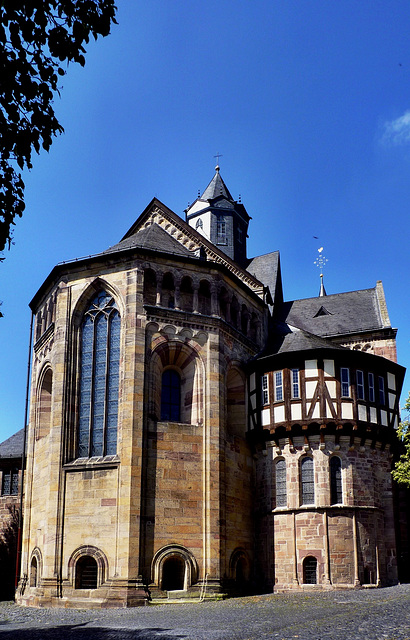Location
Keywords
Authorizations, license
-
Visible by: Everyone -
All rights reserved
-
112 visits
Fritzlar - St. Peter


This was not the best time to visit Fritzlar. Most of St. Peter was hidden behind screens, due to a longterm renovation - cloister, museum and treasury were temporarly closed.
This church is tightly connected to Saint Bonifatius (aka "Wynfnith", "Winfrid") the most important christian missionary in the east of the Frankish Kingdom, preaching the gospel to the germanic tribes.
The "Vita sancti Bonifati", written only some decades after his martyrdom in 755, tells, that Saint Bonitatius came to this place and chopped down a sacred oak, dedicated to the pagan god Thor (Donar). All onlookers were waiting for Thor´s fierce reaction, but Thor did not care. After the felling Saint Bonifatius used the timber - and had a wooden church built here. There is a statue in front of the church, that shows Bonifatius standing on the stub of a oak, holding a huge axe. He founded a monastery nearby and named Saint Wigbert the first abbot. Saint Wigbert replaced the humble wooden structure by a prestigious stone one. This was probably the church that archeologists found traces of. It dates back to the end of the 8th century. Times were hard, in 774 pagan Saxons destroyed the abbey, but the stone church (23 meters.long), obviously withstook the attacs.
But the Saxons returned in 1079 - and this time, they looted and destroyed the abbey, the church and the settlement. The building of a three nave, flat roofed basilica started 1085/1090 and was completed in 1118. It was an impressing large church with an extensive westwork, but already in 1171 the visiting Archbishop found the structure in such a bad state, the he commisioned a "rebuilding", what, as the romanesque style had changed created a "new church".
Nowadays many architectural styles can be found here, as architects and builders were busy all the time.
The choir seen from east. The large crypts are the oldest parts of the structure, dating back to the church of 1118. The windows of the crypts can be seen here. The large gothic window in the center replaced a smaller romanesque.
The half-round structure to the right has three architectonial "layers". The small windows open to the crypt inside from 1118. The next level was added during the late romanesque/early gothic area within the 13th century, while the half timbered top level was done around 1560.
This church is tightly connected to Saint Bonifatius (aka "Wynfnith", "Winfrid") the most important christian missionary in the east of the Frankish Kingdom, preaching the gospel to the germanic tribes.
The "Vita sancti Bonifati", written only some decades after his martyrdom in 755, tells, that Saint Bonitatius came to this place and chopped down a sacred oak, dedicated to the pagan god Thor (Donar). All onlookers were waiting for Thor´s fierce reaction, but Thor did not care. After the felling Saint Bonifatius used the timber - and had a wooden church built here. There is a statue in front of the church, that shows Bonifatius standing on the stub of a oak, holding a huge axe. He founded a monastery nearby and named Saint Wigbert the first abbot. Saint Wigbert replaced the humble wooden structure by a prestigious stone one. This was probably the church that archeologists found traces of. It dates back to the end of the 8th century. Times were hard, in 774 pagan Saxons destroyed the abbey, but the stone church (23 meters.long), obviously withstook the attacs.
But the Saxons returned in 1079 - and this time, they looted and destroyed the abbey, the church and the settlement. The building of a three nave, flat roofed basilica started 1085/1090 and was completed in 1118. It was an impressing large church with an extensive westwork, but already in 1171 the visiting Archbishop found the structure in such a bad state, the he commisioned a "rebuilding", what, as the romanesque style had changed created a "new church".
Nowadays many architectural styles can be found here, as architects and builders were busy all the time.
The choir seen from east. The large crypts are the oldest parts of the structure, dating back to the church of 1118. The windows of the crypts can be seen here. The large gothic window in the center replaced a smaller romanesque.
The half-round structure to the right has three architectonial "layers". The small windows open to the crypt inside from 1118. The next level was added during the late romanesque/early gothic area within the 13th century, while the half timbered top level was done around 1560.
- Keyboard shortcuts:
Jump to top
RSS feed- Latest comments - Subscribe to the comment feeds of this photo
- ipernity © 2007-2024
- Help & Contact
|
Club news
|
About ipernity
|
History |
ipernity Club & Prices |
Guide of good conduct
Donate | Group guidelines | Privacy policy | Terms of use | Statutes | In memoria -
Facebook
Twitter

Sign-in to write a comment.